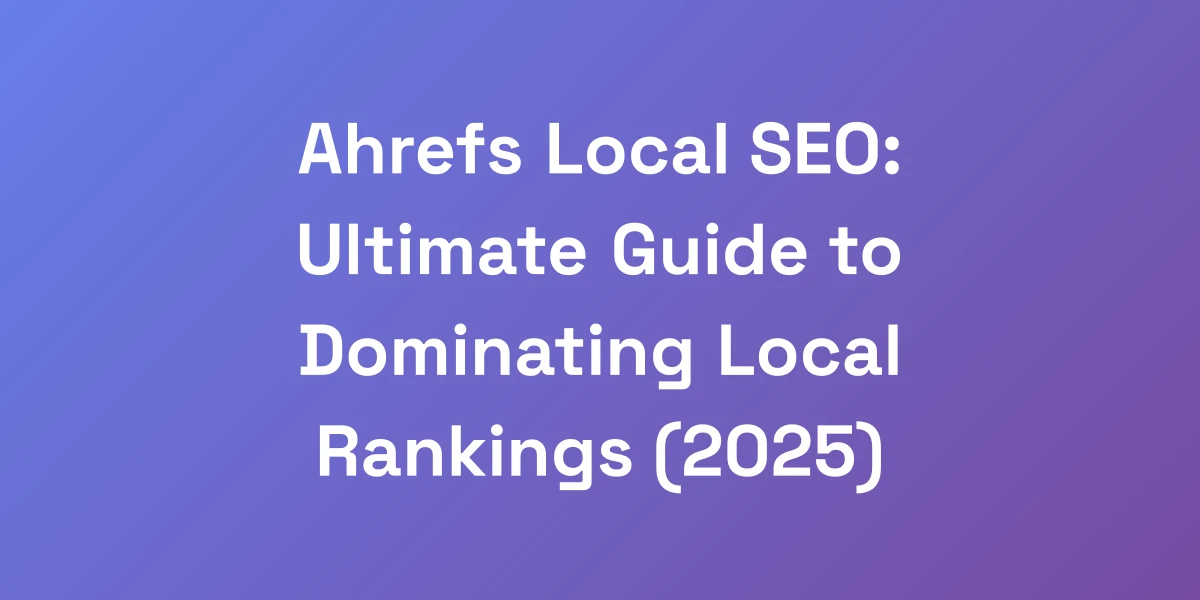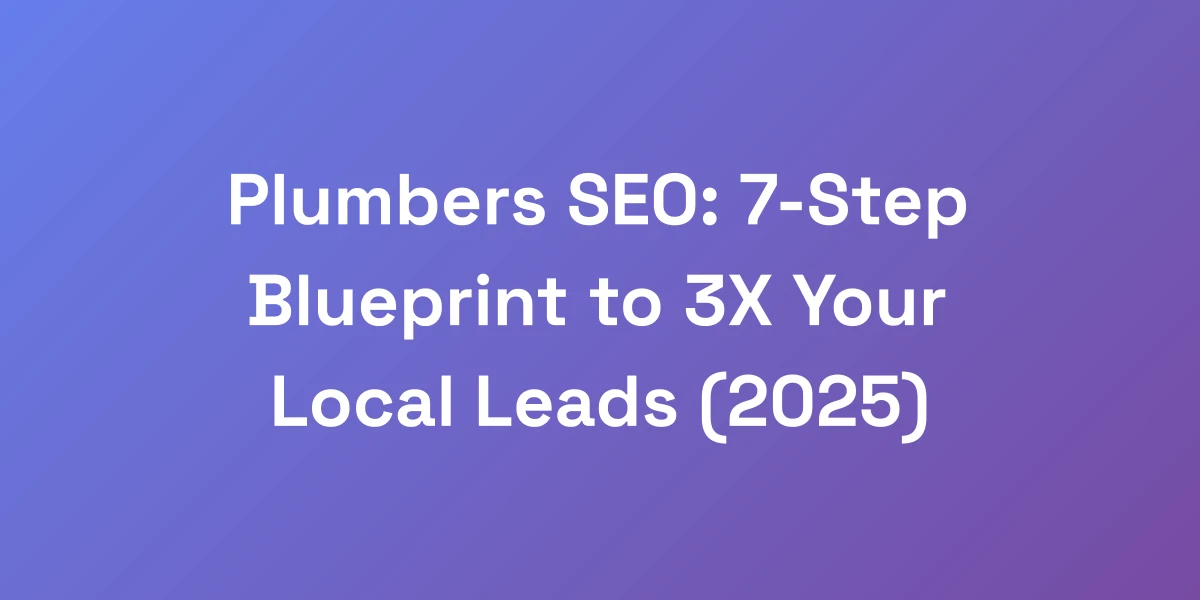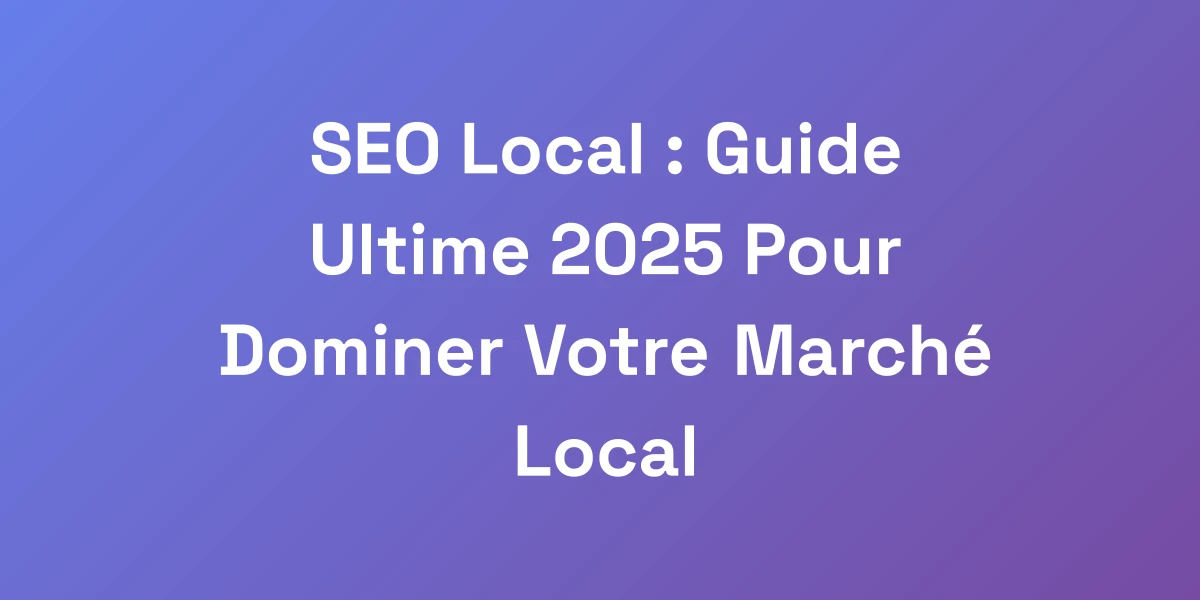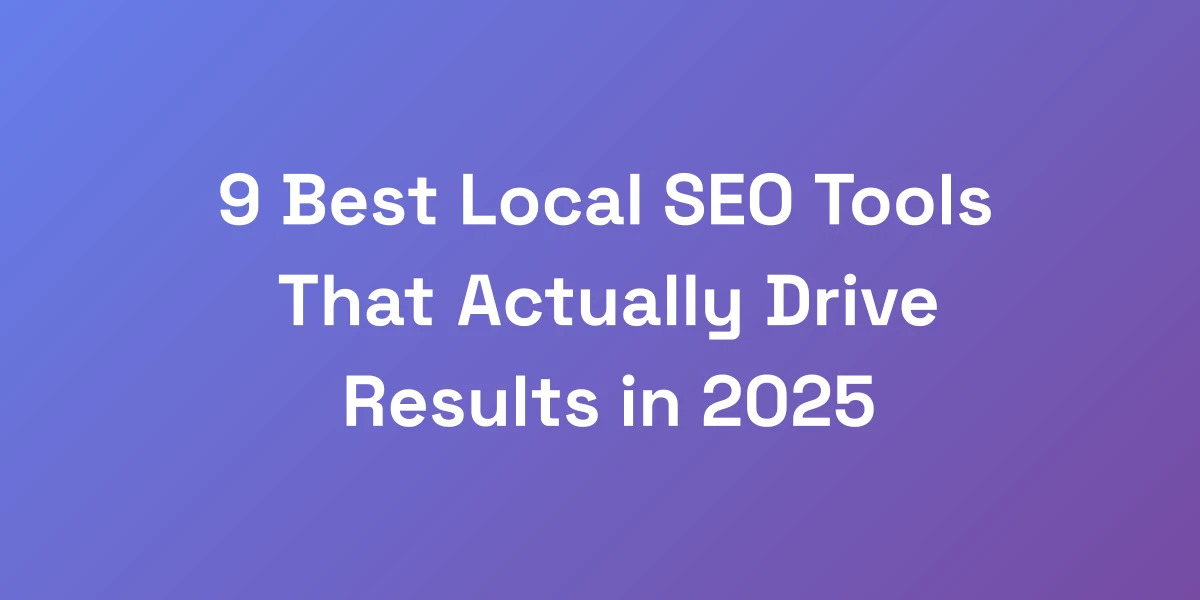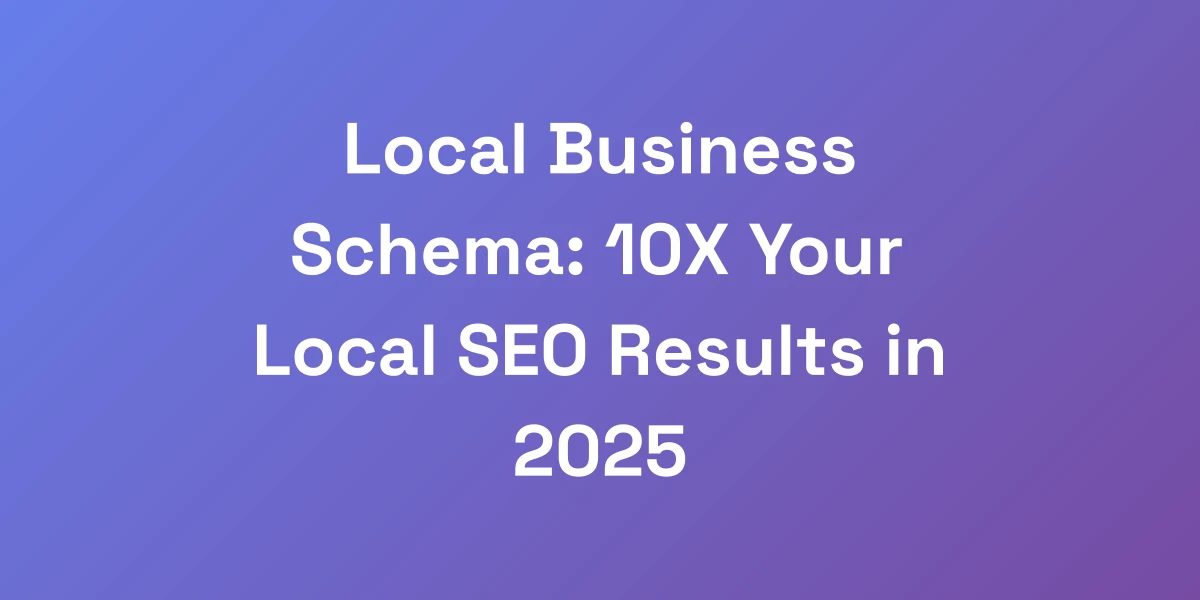
Local Business Schema: 10X Your Local SEO Results in 2025
Apr 1, 2025 | By [email protected]
Why Local Business Schema Is Your Secret Weapon for Dominating Local Search
Let us cut through the BS and tell you straight: if you’re not using local business schema, you’re leaving money on the table.
Period. We’ve seen it time and again—businesses struggle to gain traction locally because they’re missing out on this critical tool.
Imagine this: a 36.6% improvement in SEO visibility just by implementing schema markup. That’s not a typo.
While your competitors are fighting over basic SEO tactics, you could be sending crystal-clear signals to Google about exactly who you are and what you offer.
This isn’t just another SEO tactic; it’s your unfair advantage in the local market.
The Real Impact of Schema on Local Search Rankings
Let’s talk numbers. Schema markup can boost your local SEO visibility by up to 36.6%. Think about the difference that can make in your traffic and, ultimately, your revenue.
When you implement schema, you’re helping search engines understand your business better. This clarity allows Google to present your business information more effectively in search results.
For example, a local bakery using schema can highlight its address, operating hours, and customer reviews, making it easier for potential customers to find and choose you over competitors.
- Increased Visibility: Schema helps your business stand out in search results with rich snippets, attracting more clicks.
- Enhanced Relevance: By clearly defining your services and offerings, you match better with user search intent.
- Improved User Experience: Users get the information they need directly in the search results, reducing friction and improving engagement.
How Google Uses Schema to Display Rich Results
Google leverages schema to create rich results that go beyond the standard blue links.
These rich results include additional information like ratings, prices, and images, making your listing more attractive.
Consider a local restaurant: with schema, your listing can show customer ratings, average meal prices, and even photos of your dishes.
- Rich Snippets: Display key information directly in search results, increasing click-through rates.
- Knowledge Graph Integration: Enhance your presence in Google’s Knowledge Graph for better brand recognition.
- Local Pack Presence: Improve your chances of appearing in the coveted local pack results, driving more foot traffic.
Case Study: From Page 3 to Featured Snippet Using Schema
Take Rakuten, for example. After implementing recipe schema, their time on site increased by 1.5 times. This isn’t a fluke; it’s a testament to the power of schema.
By marking up their recipes with schema, Rakuten made it easier for Google to understand and display their content in rich snippets.
The result? More visibility, more clicks, and ultimately more engagement from users searching for recipes.
- Initial Challenge: Low visibility on search results pages.
- Action Taken: Implemented recipe schema markup.
- Outcome: Significant increase in site engagement and time spent by users.
The Cost of Not Implementing Local Business Schema
Not using schema markup means you’re missing out on numerous opportunities to enhance your SEO.
Without schema, your business information might be less visible and less attractive in search results, leading to lower click-through rates and fewer customers.
Think about it: every day, businesses are leveraging schema to gain an edge. If you’re not on board, you’re falling behind.
For startups, focusing on SEO for startups can help you capitalize on schema benefits more effectively and compete with established businesses.
- Lost Visibility: Missed opportunities to appear in rich snippets and the local pack.
- Lower Engagement: Fewer clicks and less traffic due to non-optimized search listings.
- Competitive Disadvantage: Competitors using schema are likely attracting more customers.
Schema vs. Traditional Local SEO: The Numbers Don’t Lie
Traditional local SEO focuses on optimizing content, building citations, and managing reviews. While these are important, schema markup takes it a step further by providing structured data to search engines.
Statistics show that local businesses using schema see a 36.6% improvement in SEO visibility, compared to those relying solely on traditional methods.
- Enhanced Data: Schema offers detailed, structured information that traditional SEO can’t match.
- Higher Engagement: Rich snippets and enhanced listings lead to a 58% higher click-through rate.
- Better Rankings: Increased visibility and relevance can indirectly boost your search rankings.
The Ultimate Local Business Schema Implementation Blueprint
We’re about to show you exactly how to implement local business schema the right way—no fluff, no theory, just pure execution.
This is the exact process we use for our 7-figure clients, and it works every single time. The key is in the details and precision.
Most people get this wrong because they copy-paste generic code. But here’s the truth: customization and accuracy are what separate the winners from the losers in local search.
Let us break down our proven system that’s generated millions in local business revenue.
Step-by-Step Schema Markup Creation Guide
First things first: creating your schema markup from scratch ensures that it’s tailored to your specific business needs.
Here’s how we approach it:
- Identify Relevant schema types: Determine the types that best describe your business, such as
LocalBusiness,Restaurant, orStore. - Gather Essential Information: Collect all necessary details like business name, address, phone number, operating hours, and services offered.
- Create Schema Markup: Use JSON-LD to format your schema markup, ensuring it’s error-free and compliant with Schema.org standards.
- Implement on Your Website: Add the schema markup to the relevant pages, typically the homepage or contact page.
- Validate Your Markup: Use tools like Google’s Rich Results Test to ensure your schema is correctly implemented.
Essential Properties You Must Include
Not all schema properties are created equal. To maximize the impact, focus on these essential properties:
- Name: Your business’s official name.
- Address: Complete and accurate physical address.
- Telephone: A phone number where customers can reach you.
- Opening Hours: Detailed operating hours for each day of the week.
- Website: Your business’s official website URL.
- Geo Coordinates: Latitude and longitude for precise location mapping.
- Price Range: Indicate the general price range of your products or services.
Advanced Schema Properties for Maximum Impact
To truly dominate local SEO, you need to go beyond the basics. Here are some advanced properties to consider:
- Menu: For restaurants, include your menu items and prices.
- Aggregate Rating: Showcase your average ratings and total number of reviews.
- Events: Highlight upcoming events to attract more attendees.
- Images: Add high-quality images to make your listing more appealing.
- Social Profiles: Link to your social media profiles to enhance credibility.
Tools and Validators to Ensure Perfect Implementation
Ensuring your schema markup is flawless is crucial. Here are the tools we swear by:
- Google’s Rich Results Test: [https://search.google.com/test/rich-results](https://search.google.com/test/rich-results)
- Schema.org Structured Data Markup Validator: [https://validator.schema.org/](https://validator.schema.org/)
- Google Search Console: [https://console.cloud.google.com/](https://console.cloud.google.com/)
These tools help you catch and fix errors, ensuring your schema is correctly implemented and eligible for rich results. Additionally, exploring search engine optimization automation can help streamline your entire SEO process.
Common Implementation Mistakes That Kill Results
Implementing schema isn’t just about adding the code. Avoid these common pitfalls to ensure success:
- Incomplete Information: Missing essential properties can reduce the effectiveness of your schema.
- Incorrect Formatting: Errors in JSON-LD syntax can prevent search engines from reading your schema.
- Duplicate Schemas: Avoid duplicate markup on multiple pages, which can confuse search engines.
- Outdated Information: Keep your schema updated with the latest business details.
- Ignoring Validation: Always validate your schema to catch and fix errors immediately.
Schema Testing and Troubleshooting Protocol
Once you’ve implemented your schema, testing and troubleshooting are vital to ensure everything is working as it should.
Here’s our step-by-step protocol:
- Run Tests: Use Google’s Rich Results Test and Schema.org’s validator to check your schema.
- Analyze Results: Look for any errors or warnings and understand what needs fixing.
- Fix Issues: Correct any errors identified during testing, whether they’re syntax-related or missing properties.
- Re-Test: After making fixes, run the tests again to confirm all issues are resolved.
- Monitor Performance: Use Google Search Console to monitor how your schema is performing and identify any new issues.
By regularly analyzing your schema performance, you can identify what’s working and where improvements are needed, ensuring sustained SEO success. For individual professionals, resources on SEO freelancing can provide additional strategies to optimize your offerings and services.
Leveraging Schema for Multiple Location Businesses
Here’s where things get interesting – and where most “experts” get it completely wrong.
Managing schema for multiple locations isn’t just about duplicating code.
It’s about strategic implementation that avoids cannibalization while maximizing local relevance for each location.
We’ve seen businesses triple their local presence across different locations using our advanced schema strategy.
The secret lies in proper hierarchy and relationship mapping between locations.
Organization Schema Hierarchy Explained
When dealing with multiple locations, it’s essential to establish a clear hierarchy within your schema.
Start with the Organization type at the top level, representing your entire business entity.
Underneath, use Branch or LocalBusiness types for each individual location.
- Organization: Represents the parent company with overarching details.
- Branch/LocalBusiness: Represents each specific location with its own unique information.
This structure ensures that each location is properly linked to the parent organization, enhancing clarity for search engines.
Location-Specific Schema Customization
Each location should have customized schema markup reflecting its unique attributes.
For instance, a retail chain might have different store hours or special offers at different locations.
- Unique Details: Include information unique to each location, such as specific services or promotions.
- Consistent Formatting: Maintain a consistent format across all locations for ease of understanding by search engines.
- Localized Content: Incorporate local keywords and phrases relevant to each specific area.
This approach ensures that each location is accurately represented and optimized for its local audience.
Managing Parent-Child Relationships in Schema
Properly managing the parent-child relationships in your schema is crucial for avoiding hierarchical confusion.
Ensure that each LocalBusiness schema references the parent Organization schema.
- Parent Schema: Contains overarching information about the business as a whole.
- Child Schema: Contains specific information about each individual location.
This setup helps search engines understand the relationship between your main business and its various locations, enhancing the overall SEO strategy.
Schema Implementation for Franchise Businesses
Franchise businesses present unique challenges, but a well-structured schema strategy can address them effectively.
- Consistent Branding: Use the
Organizationschema to maintain consistent branding across all franchises. - Local Details: Each franchise location should have its own
LocalBusinessschema with local details. - Centralized Management: Implement a centralized system for managing and updating schema across all franchise locations.
This ensures that each franchise location is accurately represented while maintaining cohesive branding and information structure.
Cross-Location Schema Strategy
A cross-location schema strategy involves linking multiple locations to enhance their collective SEO performance.
- Interlinked Schemas: Ensure that schemas for different locations reference each other where appropriate.
- Consistent Information: Maintain consistent business information across all locations to build trust with search engines.
- Localized Optimization: Tailor each location’s schema to target its specific local market effectively.
This strategy helps in creating a robust network of schemas that collectively boost your local SEO results.
Avoiding Multi-Location Schema Pitfalls
Many businesses stumble when managing schema for multiple locations. Here are common pitfalls and how to avoid them:
- Duplicated Information: Avoid duplicating the same information across schemas, which can confuse search engines.
- Lack of Customization: Ensure each location’s schema is tailored to its unique characteristics.
- Incorrect Hierarchy: Maintain a clear parent-child hierarchy to prevent search engines from misinterpreting your structure.
- Neglecting Validation: Regularly validate each schema to catch and fix errors promptly.
By steering clear of these mistakes, you can ensure that your multi-location schema strategy is both effective and efficient.
Advanced Schema Optimization Techniques That 10X Results
Listen up, because this is where we separate the amateurs from the pros.
Basic schema implementation is just the beginning.
The real magic happens when you start layering advanced optimization techniques.
We’re talking about combining different schema types, implementing dynamic updates, and creating schema relationships that make Google’s algorithm work in your favor.
In addition, leveraging AI-powered SEO automation can further enhance your schema implementation.
These are the strategies that took our clients from struggling to dominate their local markets.
Combining Multiple Schema Types for Maximum Impact
Don’t limit yourself to just one schema type. Combining multiple types can provide a more comprehensive view of your business to search engines.
- LocalBusiness and Review: Merge your local business schema with review schemas to showcase customer feedback.
- Product Schema: If you sell products, incorporate product schemas to display detailed information directly in search results.
- Event Schema: Highlight upcoming events to attract more attendees and increase engagement.
This multi-faceted approach gives search engines a richer dataset to work with, enhancing your visibility and attractiveness in search results.
Dynamic Schema Updates for Time-Sensitive Content
Keeping your schema markup up-to-date is crucial, especially for time-sensitive content like promotions or events.
- Automated Updates: Use dynamic scripts to update schema markup in real-time as your content changes.
- Seasonal Adjustments: Adjust operating hours or special offers based on seasons or holidays.
- Real-Time Data: Integrate real-time data feeds to keep your information current and relevant.
By ensuring your schema reflects the latest information, you maintain relevance and accuracy, which search engines and users appreciate.
Schema Breadcrumb Implementation
Breadcrumbs enhance user navigation and provide additional context to search engines.
- Structured Navigation: Implement breadcrumb schema to showcase your site’s structure.
- Enhanced Search Listings: Breadcrumbs in search results help users understand the hierarchy and navigate your site more efficiently.
- Improved User Experience: Clear navigation paths reduce bounce rates and increase engagement.
Breadcrumb schema not only benefits users but also helps search engines parse your site’s structure accurately.
Review and Rating Schema Integration
Integrating review and rating schemas can significantly boost your credibility and attractiveness in search results.
- Showcase Feedback: Display customer reviews and ratings directly in search results.
- Build Trust: High ratings and positive reviews enhance your business’s trustworthiness.
- Encourage Engagement: Detailed reviews encourage potential customers to choose your business over competitors.
By highlighting customer feedback, you not only improve your SEO but also build a stronger connection with your audience.
Event and Special Offer Schema Implementation
Highlighting events and special offers through schema can drive more traffic and engagement.
- Promote Events: Use event schema to showcase upcoming events and attract attendees.
- Highlight Offers: Use offer schema to display special deals and promotions, enticing users to take action.
- Increase Visibility: Events and offers in search results catch users’ attention, leading to higher click-through rates.
These schema types make your offerings more visible and appealing, driving more traffic to your site and business.
Schema Analytics and Performance Tracking
To optimize your schema strategy, you need to track and analyze its performance.
- Set Up Analytics: Use Google Analytics and Google Search Console to monitor schema performance.
- Track Key Metrics: Focus on metrics like click-through rates, impressions, and engagement rates.
- Iterate and Improve: Use the data to refine and enhance your schema implementation continually.
By regularly analyzing your schema performance, you can identify what’s working and where improvements are needed, ensuring sustained SEO success. For individual professionals, resources on SEO freelancing can provide additional strategies to optimize your offerings and services.
Future-Proofing Your Local Business Schema Strategy
The biggest mistake we see businesses make is implementing schema once and forgetting about it.
The game is constantly changing, and your schema strategy needs to evolve.
We’re going to show you how to stay ahead of the curve and maintain your competitive edge.
We’ve developed a systematic approach to monitoring, updating, and optimizing schema that ensures long-term success in local search.
This isn’t about quick wins – it’s about building a sustainable competitive advantage.
Upcoming Schema Markup Trends
Stay updated with the latest trends in schema markup to keep your strategy relevant and effective.
- Enhanced AI Integration: As AI evolves, schema markup will become more sophisticated in how it interacts with search algorithms.
- New Schema Types: Keep an eye out for new schema types that better describe your evolving business offerings.
- Improved Rich Snippets: Expect more detailed and interactive rich snippets as search engines continue to enhance user experience.
By staying informed about these trends, you can proactively adjust your schema strategy to leverage new opportunities.
AI and Schema: The Next Evolution
AI is revolutionizing how search engines interpret schema data.
- Machine Learning Enhancements: AI algorithms can better understand and utilize schema data, making your markup even more impactful.
- Personalized Search Results: AI allows for more personalized search experiences, meaning your schema needs to cater to varied user intents.
- Automated Schema Creation: Future tools may leverage AI to automate schema generation based on your content, ensuring accuracy and efficiency.
Embracing AI advancements will keep your schema strategy cutting-edge and highly effective.
Mobile-First Schema Considerations
With the majority of searches happening on mobile devices, your schema strategy must be mobile-first.
- Responsive Design: Ensure that your schema is optimized for mobile displays, providing relevant information without clutter.
- Fast Loading: Mobile users expect quick access to information, so ensure your schema doesn’t slow down your site.
- Voice Search Compatibility: Optimize your schema for voice search, which is prevalent on mobile devices.
Focusing on mobile-first schema considerations ensures that you capture the growing mobile search market effectively.
Voice Search Optimization Through Schema
Voice search is on the rise, making voice optimization a crucial part of your schema strategy.
- Conversational Keywords: Use natural language and conversational keywords in your schema to match voice search queries.
- FAQ Schema: Implement FAQ schema to answer common voice search questions directly.
- Structured Responses: Provide clear and concise information in your schema to facilitate quick and accurate voice search responses.
Optimizing for voice search through schema ensures that your business is easily accessible to users relying on voice assistants.
Schema Monitoring and Update Protocol
Consistency is key to maintaining an effective schema strategy. Here’s how we do it:
- Regular Audits: Conduct monthly audits using validation tools to ensure your schema remains error-free and up-to-date.
- Automated Alerts: Set up alerts in Google Search Console to notify you of any schema-related issues promptly.
- Continuous Improvement: Stay informed about changes in schema standards and update your markup accordingly.
By maintaining a rigorous monitoring and update protocol, you can ensure your schema strategy remains robust and effective over time.
Future Google Updates and Schema Preparation
Google’s search algorithm is continually evolving, and staying prepared for future updates is essential.
- Stay Informed: Follow Google’s official updates and best practices to understand upcoming changes that may affect your schema strategy.
- Adapt Quickly: Be ready to adjust your schema markup to comply with new guidelines and features introduced by Google.
- Test New Features: Experiment with new schema properties and types as they become available to stay ahead of the competition.
Preparing for future Google updates ensures that your schema strategy remains resilient and continues to deliver results despite algorithm changes.
Conclusion
To wrap it up, implementing local business schema is not just a good idea—it’s a necessity for dominating local SEO in 2025.
We’ve explored how schema can dramatically enhance your visibility, drive more traffic, and ultimately boost your revenue.
From the foundational steps of creating and validating your schema markup to advanced optimization techniques, every detail plays a critical role in your success.
Remember, the landscape is constantly evolving, and staying ahead means continually refining and updating your strategy.
Don’t let your competitors outshine you because they took the schema leap while you hesitated.
Take action today: start implementing local business schema with precision and watch your local SEO results skyrocket.
Additionally, integrating business blogging into your SEO strategy can further enhance your online presence and drive sustained growth.
Have questions or need help getting started? Drop a comment below or reach out to us directly. Let’s elevate your local business together!

